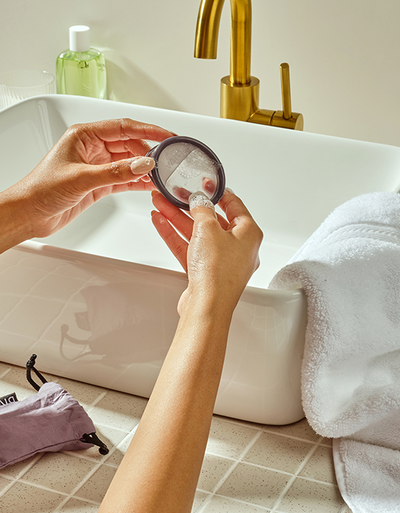

Quelle est la durée moyenne d’un cycle menstruel ? Si les moyennes nous donnent un cadre, elles négligent les variations occasionnelles. Le nombre de jours de votre cycle peut parfois fluctuer. Qu’est-ce qui cause des règles irrégulières ? Le stress, l’alimentation, l’exercice et d’autres facteurs liés au mode de vie peuvent affecter la durée de votre cycle et ne signalent pas immédiatement un dysfonctionnement. Nous découvrirons ici les facteurs contribuant aux variations.
Quelle est la durée « moyenne » d’un cycle menstruel ?
La durée d’un « cycle » menstruel est mesurée à partir du premier jour de votre saignement jusqu’au jour précédant le début de votre prochain saignement. Il est courant que les menstruations (qui ne prennent pas de pilule contraceptive hormonale) aient un cycle de 24 à 38 jours [i] .
Il existe plusieurs cas où les variations sont courantes, notamment :
- Vos premières règles, ou premières règles. Cela peut prendre plusieurs années pour que notre durée moyenne de cycle émerge.
- Si vous suivez une contraception hormonale. Vous vivez un « cycle » de 26 à 28 jours, mais en fait, il ne s’agit pas d’une perte de la muqueuse utérine. Au lieu de saignements menstruels, il s'agit de saignements de privation, provoqués par une pause de 7 jours des pilules hormonales sous placebo [ii] .
- Après l'accouchement ou pendant l'allaitement.
- Pendant périménopause , alors que votre corps se prépare à la ménopause.
Que faire si mon cycle est court/long/inexistant ?
Polyménorrhée décrit un cycle de moins de 21 jours. Oligoménorrhée est une durée de cycle de 38 à 90 jours. Aménorrhée c'est la perte d'une période en tout. Une variation occasionnelle de plus de 5 jours ne signale pas nécessairement une dérégulation ou une affection sous-jacente [iii] . Si vous avez des règles irrégulières pendant plusieurs mois, consultez votre professionnel de la santé.
Quelles sont les causes des règles irrégulières ?
Les règles irrégulières sont courantes en cas de stress, de manque de nutrition et de surexercice [iv] . L'exercice extrême et les régimes amaigrissants peuvent entraîner une baisse des niveaux d'œstrogènes. Les hormones sexuelles, les œstrogènes et la progestérone, maintiennent des ratios spécifiques pour l'équilibre hormonal et la régulation du cycle.
Trop peu d’œstrogènes peut entraîner des cycles plus courts. Des quantités insuffisantes de progestérone peuvent entraîner des cycles plus longs. Les deux peuvent entraîner des symptômes indésirables tels que des flux plus abondants, des crampes plus intenses, de l'anxiété, une perte de libido, un amincissement des cheveux, des bouffées de chaleur et des problèmes d'infertilité [v] . Ces hormones sont censées fonctionner de manière symbiotique.
Régime et exercice
Une augmentation de oligoménorrhée et aménorrhée chez les athlètes et les personnes souffrant de troubles de l'alimentation a été étudiée. Les danseurs représentent 11 à 44 % de la population souffrant d’oligoménorrhée et 6 à 60 % des athlètes déclarent en avoir souffert à un moment donné de leur vie.
L'oligoménorrhée se caractérise par un cycle menstruel répété supérieur à 35 jours ou seulement 4 à 9 cycles au total par an. L'oligoménorrhée touche 13,5 % de la population menstruée. Chez les menstruations en âge de procréer, le syndrome des ovaires polykystiques (SOPK) représente 4 à 10 % de ce chiffre [vi] .
Stresser
De même, les personnes occupant des emplois très stressants ont déclaré avoir connu des cycles plus courts. Lorsque le corps produit trop de cortisol, cela peut perturber l’hypothalamus du cerveau et interrompre le cycle menstruel. Les modes de vie sédentaires ont également été associés à des cycles menstruels plus courts. Trouver l'équilibre est donc essentielle à l’équilibre hormonal.
Autres facteurs contributifs
D'autres facteurs contribuant aux variations de la durée du cycle comprennent :
- mauvaise alimentation
- habitudes de sommeil irrégulières (décalage horaire, travail posté)
- pilules contraceptives d'urgence
- cigarettes
- consommation d'alcool
La meilleure façon de réagir aux variations du cycle est d’examiner votre mode de vie actuel. Avez-vous été très stressé ? Est-ce que tu manges correctement ? Es-tu faire de l'exercice une quantité modérée vous laissant plein d'énergie et non épuisé ? Avez-vous connu une perte de poids importante ?
Les règles sont fortement affectées par nos habitudes et nos routines. Pour vous préparer à bien-être des règles , notez la date de début et de fin de votre cycle menstruel, et marquer tout changement au cours de plusieurs mois. Si vous rencontrez un cycle de 45 jours, par exemple, gardez un œil sur vos prochains cycles et travaillez à équilibrer les facteurs liés au mode de vie qui contribuent à vos niveaux hormonaux.
Syndrome des ovaires polykystiques (SOPK) ; Qu'est-ce que c'est?
Historiquement, les prestataires de soins de santé ont rejeté les menstruations en raison de symptômes liés au cycle. En conséquence, des troubles tels que syndrome des ovaires polykystiques (SOPK) sont largement sous-diagnostiqués [vii] .
Le syndrome des ovaires polykystiques est un trouble endocrinien courant chez les menstruations en âge de procréer. Il existe 4 types différents de SOPK et, outre les règles irrégulières, il est souvent caractérisé par des symptômes tels que la perte de cheveux, l'acné, l'hirsutisme, une prise de poids incontrôlable et l'infertilité [viii] . N'hésitez pas à contacter un obstétricien ou un gynécologue de confiance pour un diagnostic et un traitement appropriés.
Vivre une vie équilibrée
Vivre une vie équilibrée signifie faire de l'exercice modérément, bien nourrir son corps, surveiller son niveau de stress et demander de l'aide pour traiter des problèmes médicaux sous-jacents si nécessaire.
Comprendre les tenants et les aboutissants de votre cycle – et en parler ouvertement – vous aide à mieux comprendre votre expérience de menstruation et contribue à la déstigmatisation des règles.









